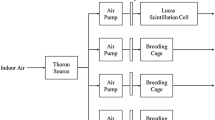Summary
Formaldehyde (FA) is a ubiquitous toxic organic compound, and it has been regarded as a leukemogen. However, the mechanisms by which FA induces bone marrow toxicity remain unclear. The present study was aimed to examine the bone marrow toxicity caused by FA and the mechanism involving the expression changes of peroxiredoxin3 (Prx3) in this process. The mice were divided into four groups with 6 mice per group. Animals in the control group were exposed to ambient air and those in the FA groups to different concentrations of FA (20, 40, 80 mg/m3) for 15 days in the separate inhalation chambers, 2 h a day. At the end of the 15-day experimental period, all mice were killed. Bone marrow cells were obtained. The level of hydrogen peroxide (H2O2), the apoptosis rate, and the activities and protein expression levels of caspase-3 and caspase-9 were determined by biochemical assay, flow cytometry and immunohistochemistry, respectively; DNA damage and Prx3 expression levels were measured by single cell gel eletrophoresis immunohistochemistry and Western blotting, respectively. The results showed that the H2O2 level and cell apoptosis rate were significantly increased in FA groups relative to the control group. Caspase-3 and caspase-9 activities and their protein expression levels were markedly increased as well. Additionally, FA also increased the rate of DNA damage and the expression level of Prx3 compared with control group. Our study suggested that a certain concentration of FA causes the bone marrow toxicity by regulating the expression of Prx3.
Similar content being viewed by others
References
Tang XQ, Ren YK, Chen RQ, et al. Formaldehyde induces neurotoxicity to PC12 cells involving inhibition of paraoxonase-1 expression and activity. Clin Exp Pharmacol Physiol, 2011,38(4):208–214
Hauptmann M, Lubin J, Stewart PA, et al. Mortality from lymphohematopoietic malignancies among workers in formaldehyde industries. J Natl Cancer Inst, 2003,95(21): 1615–1623
Cole P, Axten C. Formaldehyde and leukemia: an improbable caused relationship. Regul Toxicol Pharmacol, 2004,40:107–112
Schwilk E, Zhang L, Smith MT, et al. Formaldehyde and leukemia: an updated meta-analysis and evaluation of bias. J Occup Environ Med, 2010,52:878–886
Speit G, Gelbke HP, Pallapies D, et al. Occupational exposure to formaldehyde, hematotoxicity and leukemia-specific chromosome change in cultured myeloid progenitor cells. Cancer Epidemiol Biomarkeres Prev, 2010,19(9):1882–1884
Zhou DX, Qiu SD, Zhang J, et al. The protective effect of vitamin E against oxidative damage caused by formaldehyde in the testes of adult rats. Asian J Androl, 2006,8:584–588
Park KJ, Kim YJ, Kim J, et al. Protective effects of peroxiredoxin on hydrogen peroxide induced oxidative stress and apoptosis in cardiomyocytes. Korean Circ J, 2012,42(1):23–32
Tuteja N, Ahmad P, Panda BB, et al. Genotoxic stress in plants: shedding light on DNA damage, repair and DNA repair helicases. Mut Res, 2009,681:134–149
Cox A, Winterbourn C, Hampton M. Mitochondrial peroxiredoxin involvement in antioxidant defence and redox signaling. Biochem J, 2010,425(2):313–325
Li LQ, Obinata M, Hori K. Role of peroxiredoxin III in the pathogenesis of pre-eclampsia as evidenced in mice. Oxid Med Cell Longev, 2010,3(1):71–73
Chang TS, Cho CS, Park S, et al. Peroxiredoxin III, a mitochondrion-specific peroxidase, regulates apoptotic signaling by mitochondria. J Biol Chem, 2004,279(40): 41975–41984
Maiese K, Chong ZZ, Hou J, et al. Oxidative stress: Biomarkers and novel therapeutic pathways. Exp Gerontol, 2010,45(3):217–234
Oh MJ, Chae GY, Ahn KH, et al. Involvement of oxidized peroxiredoxin-3 in cadmium-and ceramide-induced apoptosis of human neuroblastoma cells. J Health Sci, 2009,55(5):739–749
Li XY, Zhuang ZX, Liu JJ, et al. Expression of proteins for adaptive response induced by low concentrations of hydroquinone, formaldehyde and hydrogen peroxide in human embryonic lung fibroblasts. Chin J Pharmacol Toxicol, 2007,21(5):410–415
Singh NP, Mccoy MT, Tice RR, et al. A simple technique for quantitation of low levels of DNA damage in individual cells. Exp Cell Res, 1988,175:184–191
Lu Z, Li CM, Qiao Y, et al. Effect of inhaled formaldehyde on learning and memory of mice. Indoor Air, 2008,8:77–83
Zhang L, Tang X, Rothman N, et al. Occupational exposure to formaldehyde, hematotoxicity, and leukemia-specific chromosome changes in cultured myeloid progenitor cells. Cancer Epidemiol Biomarkers Prev, 2010,19(1):80–88
Aydin S, Canpinar H, Ündeğer Ü, et al. Assessment of immunotoxicity and genotoxicity in workers exposed to low concentrations of formaldehyde. Arch Toxicol, 2013,87(1):145–153
Baan R, Grosse Y, Straif K, et al. A review of human carcinogens—Part F: Chemical agents and related occupations. Lancet Oncol, 2009,10(12):1143–1144
Ye X, Ji ZY, Wei CX, et al. Inhaled formaldehyde induces DNA-protein crosslinks and oxidative stress in bone marrow and other distant organs of exposed mice. Environ Mol Mutagen, 2013,54:705–718
Lin ZX, Luo WH, Li H, et al. The effect of endogenous formaldehyde on the rat aorta endothelial cells. Toxico Lett, 2005,159:134–143
Kim DS, Jeon SE, Jeong YM, et al. Hydrogen peroxide is a mediator of indole-3-acetic acid/horseradish peroxidase-induced apoptosis. FEBS Lett, 2006,580:1439–1446
Qun YZ, Yun ZG. Mitochondria and apoptosis. Jiepou Kexue Jinzhan (Chinese), 2006,12(1):60–62
Ott M, Gogvadze V, Orrenius S. Mitochondria, oxidative stress and cell death. Apoptosis, 2007,12(5):913–922
Brown K, Erihsson SE, Amer ES, et al. Mitochondrial peroxiredoxin 3 is rapidly oxidized in cells treated with isothiocyanates. Free Radic Biol Med, 2008,45(4): 494–502
Cheng WW, Lin ZQ, Wei BF, et al. Single-walled carbon nanotube induction of rat aortic endothelial cell apoptosis: Reactive oxygen species are involved in the mitochondrial pathway. Int J Biochem Cell Biol, 2011,43:564–572
Taylor RC, Cullen SP, Martin SJ. Apoptosis: controlled demolition at the cellular level. Nat Rev Mol Cell Biol, 2008,9:231–241
Cox AG, Brown K, Amer ES, et al. The thioredoxin reductase inhibitor auranofin triggers apoptosis through a Bax/Bak-dependent process that involves peroxiredoxin 3 oxidation. Biochem Pharmacol, 2008,76(9):1097–1109
Author information
Authors and Affiliations
Corresponding author
Rights and permissions
About this article
Cite this article
Yu, Gy., Song, Xf., Zhao, Sh. et al. Formaldehyde induces the bone marrow toxicity in mice by regulating the expression of Prx3 protein. J. Huazhong Univ. Sci. Technol. [Med. Sci.] 35, 82–86 (2015). https://doi.org/10.1007/s11596-015-1393-6
Received:
Revised:
Published:
Issue Date:
DOI: https://doi.org/10.1007/s11596-015-1393-6




